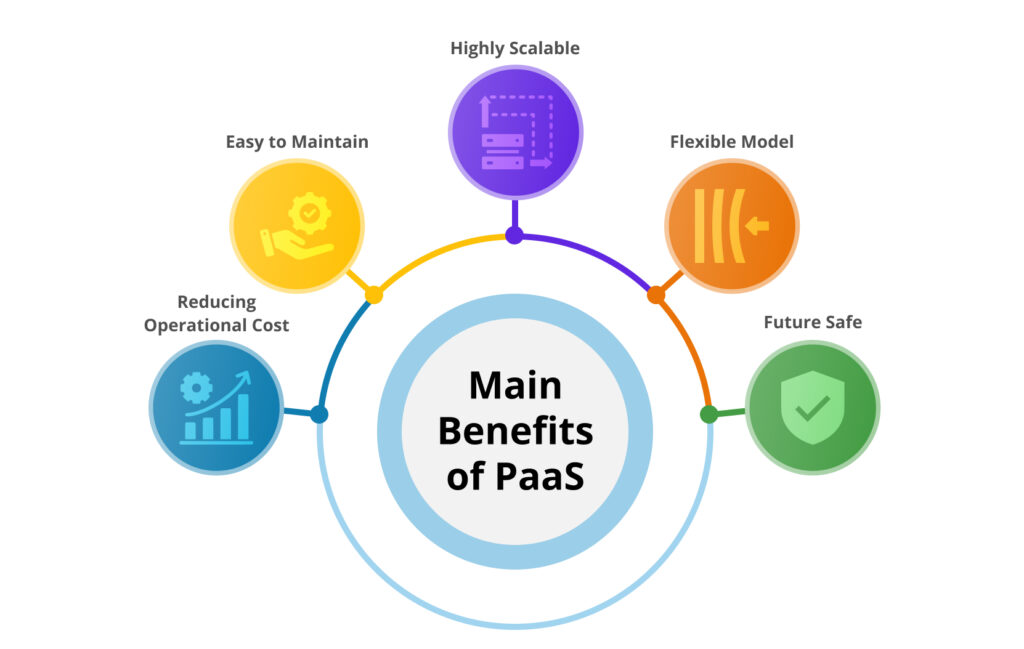Platform as a Service, abbreviated as PaaS, is a cloud computing delivery model whereby a user gets access from the provider in the cloud to the platforms and tools required to develop, test, and run applications: operating systems, DBMSs, development environments, and others. PaaS is also commonly used to describe a comprehensive cloud environment to build, run, and further host applications.
The PaaS cloud is used not only as a development environment. For example, it’s a great solution for data analytics. Companies can study trends, detect patterns, and predict outcomes to make better-informed business decisions. PaaS platforms also often offer add-on services that can boost application performance.
As a reminder, PaaS is one of the three most common cloud models, along with IaaS and SaaS. We have discussed the distinctions between IaaS, PaaS and SaaS in a dedicated blog.
Benefits of PaaS
- High availability. Businesses do not have to waste time and resources on configuring the respective software, namely environment and tools for product development/testing/deployment, libraries for working with Machine Learning, databases, analytical and other tools.
- Accelerating application development and delivery. Developers get immediate access to the necessary environments and tools (including advanced and expensive ones) without wasting time on deploying and maintaining the IT infrastructure involved.
- Reducing development costs. There are no capital expenditures on IT infrastructure, all systems are kept up-to-date by the provider and do not require the involvement of highly specialised experts. Moreover, services are paid via pay-as-you-go model. Advanced development features are available without increasing the number of in-house staff.
- Simplified development for different platforms. PaaS cloud computing can reduce cross-platform development time when the desktop and mobile versions of the same application are required.
- Easy scaling. When the number of your projects increases, or your demand fluctuates, you can easily get all the resources you need to get it done and then go back to prior capacity if you no longer need extra resources.
- Effective application lifecycle management. PaaS has everything to support applications through the entire lifecycle: from development to deployment, management, and subsequent upgrades.
- Convenient facilities for geographically dispersed teams. To access PaaS, all you need is a device with an Internet connection, and the developers can work from anywhere in the world at any time.
- Reduced operational and other development-related tasks. Due to the fact that more resources can be managed at the stack level in a PaaS cloud, the operational load on both the developers and the IT department as a whole is reduced.

How does PaaS work?
PaaS in cloud computing has a rather specific and narrow scope: developing web applications and traditional software. Developers, who constitute core PaaS users, connect to them via the Internet. Meanwhile, any number of users or teams can work on the same project from anywhere in the world – it is enough to have a device with a stable connection.
What does PaaS cloud computing service consist of?
- cloud infrastructure, including servers, storage, networking hardware and all the necessary life support systems to keep the data centre running smoothly;
- middleware (Middleware as a Service), including OSs, specialised platforms, SDKs, preconfigured libraries, DBMSs;
- user interface, including graphical user interface (GUI), command line interface (CLI), APIs – either separately or all at once.
Colobridge’s Expert:
“PaaS cloud computing PaaS cloud computing is something special – it is not just a cloud environment but also a set of preconfigured development tools. At the same time, some teams are ready to work with a “blank cloud” via IaaS (“Infrastructure as a Service“) and deploy and maintain all the necessary tools on their own. Developers can use IaaS as a platform to store backups, test applications in an environment as close to the real as possible, and perform other tasks. Whereas in PaaS they don’t get to choose and use only that which the provider provides, in IaaS they can install and configure anything and in whatever manner they want it in addition to self-administration. Although it will involve more work initially, it will be further transformed into a platform tailored to specific needs.”
To learn more about the features Colobridge platform has to offer for developing and testing applications, please contact our experts – call, message us on social networks or fill out the feedback form on this page.
